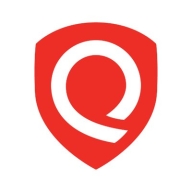

Qualys VMDR and Red Hat Advanced Cluster Security for Kubernetes compete in the vulnerability management and Kubernetes security category. Red Hat appears to have the upper hand due to its robust features tailored specifically for Kubernetes environments.
Features: Qualys VMDR excels in vulnerability detection, policy compliance, and comprehensive reporting. It also offers continuous monitoring capabilities that improve its usability. Red Hat Advanced Cluster Security for Kubernetes focuses on network mapping, container security, and effective cluster management, which is particularly beneficial for enterprises using Kubernetes at scale.
Room for Improvement: Qualys VMDR users seek enhancements in reporting and dashboard customization, and find the user interface complex. Red Hat Advanced Cluster Security users point out the need for improved documentation, API integration, and container security visibility. Setup and user guidance could be made more intuitive.
Ease of Deployment and Customer Service: Qualys VMDR supports deployment across hybrid cloud, private cloud, and on-premises environments. However, customer service receives mixed reviews regarding responsiveness. Red Hat is typically deployed on-premises, offering responsive customer service that effectively addresses client concerns.
Pricing and ROI: Qualys VMDR is generally seen as expensive for smaller organizations but offers good value through enhanced security and reduced risk, resulting in positive ROI. Red Hat, though associated with higher costs, provides flexible pricing, including bundled options with OpenShift Platform Plus, making it cost-effective. Both solutions yield significant returns in operational security and compliance.
| Product | Market Share (%) |
|---|---|
| Qualys VMDR | 2.4% |
| Red Hat Advanced Cluster Security for Kubernetes | 2.2% |
| Other | 95.4% |

| Company Size | Count |
|---|---|
| Small Business | 20 |
| Midsize Enterprise | 12 |
| Large Enterprise | 69 |
| Company Size | Count |
|---|---|
| Small Business | 6 |
| Midsize Enterprise | 2 |
| Large Enterprise | 4 |
Vulnerability Management, Detection, and Response (VMDR) is a cornerstone product of the Qualys TruRisk Platform and a global leader in the enterprise-grade vulnerability management (VM) vendor space. With VMDR, enterprises are empowered with visibility and insight into cyber risk exposure - making it easy to prioritize vulnerabilities, assets, or groups of assets based on business risk. Security teams can take action to mitigate risk, helping the business measure their actual risk exposure over time.
Qualys VMDR offers an all-inclusive risk-based vulnerability management solution to prioritize vulnerabilities and assets based on risk and business criticality. VMDR seamlessly integrates with configuration management databases (CMDB), Qualys Patch Management, Custom Assessment and Remediation (CAR), Qualys TotalCloud and other Qualys and non-Qualys solutions to facilitate vulnerability detection and remediation across the entire enterprise.
With VMDR, users are empowered with actionable risk insights that translate vulnerabilities and exploits into optimized remediation actions based on business impact. Qualys customers can now aggregate and orchestrate data from the Qualys Threat Library, 25+ threat intelligence feeds, and third-party security and IT solutions, empowering organizations to measure, communicate, and eliminate risk across on-premises, hybrid, and cloud environments.
Red Hat Advanced Cluster Security for Kubernetes is a Kubernetes-native container security solution that enables your organization to more securely build, deploy, and run cloud-native applications from anywhere. With its built-in security across the entire software development life cycle, you can lower your operational costs, reduce operational risk, and increase developer productivity while improving your security posture immediately. In addition, Red Hat Advanced Cluster Security integrates with security tools and DevOps in an effort to help you mitigate threats and enforce security policies that minimize operational risk to your applications. It also enables you to provide developers with actionable, context-rich guidelines integrated into existing workflows, along with tooling to support developer productivity. The solution is suitable for small, medium, and large-sized companies.
Red Hat Advanced Cluster Security for Kubernetes Features
Red Hat Advanced Cluster Security for Kubernetes has many valuable key features. Some of the most useful ones include:
Red Hat Advanced Cluster Security for Kubernetes Benefits
There are many benefits to implementing Red Hat Advanced Cluster Security for Kubernetes. Some of the biggest advantages the solution offers include:
Reviews from Real Users
PeerSpot user Igor K., Owner/Full Stack Software Engineer at Maraphonic, Inc., says, “The solution allows teams to create their own virtual spaces and share resources. The most valuable feature is the ability to share resources.”
We monitor all Container Security reviews to prevent fraudulent reviews and keep review quality high. We do not post reviews by company employees or direct competitors. We validate each review for authenticity via cross-reference with LinkedIn, and personal follow-up with the reviewer when necessary.